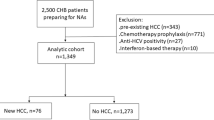Summary
To investigate the influence of hepatitis C virus (HCV) infection on patients with chronic hepatitis B virus (HBV), the presence of antibody against C100-3 antigen of HCV (anti-HCV) was examined in 420 patients with chronic HBV infection and 275 healthy subjects. It was found that the prevalence of HCV infection increased in parallel with the severity of liver damage. The positive rates of anti-HCV were as follows: healthy subjects, 2.9% (8/275); asymptomatic carriers, 2.6% (5/193); chronic hepatitis, 5.2% (3/58); liver cirrhosis, 11.4% (8/70); hepatocellular carcinoma (HCC), 12.1% (12/99). To elucidate the interaction of these two viruses in hepatocellular carcinoma, 128 HCC patients and 384 age-matched and sex-matched subjects were further analyzed. Eighty-seven of 128 HCC patients (68.0%) were only positive for HBsAg, 13 patients (10.1%) were only anti-HCV positive, and 12 (9.4%) were positive for both markers. The presence of HBsAg and anti-HCV was associated strongly with HCC. Moreover, the risk of HCC was significantly higher when both HBsAg and anti-HCV were present simultaneously. These results suggested that concurrent HCV infection might accelerate the progression of chronic HBV infection and may contribute to the pathogenesis of HCC in patients with chronic HBV infection.
Similar content being viewed by others
References
Kuo G, Choo QL, Alter HJ, et al. An assay for circulating antibodies to a major etiologic virus for human non-A, non-B hepatitis. Science 1989;244: 362–364.
Alter HJ, Purcell RH, Shih JW, et al. Detection of antibody to hepatitis C virus in prospectively followed transfusion recipients with acute and chronic non-A, non-B hepatitis. N Engl J Med 1989;321: 1494–1500.
Sherlock S. Viral hepatitis. Diseases of the Liver and Biliary System. 8th ed. Oxford: Blackwell Scientific Publications, 1989;301–338.
Villa E, Baldini GM, Pasquinelli C, et al. Risk factors for hepatocellular carcinoma in Italy. Male sex, hepatitis B virus, non-A non-B infection, and alcohol. Cancer 1988;62: 611–615.
Sakamoto M, Hirohashi S, Tsuda H, et al. Increasing incidence of hepatocellular carcinoma possibly associated with non-A, non-B hepatitis in Japan, disclosed by hepatitis B virus DNA analysis of surgically resected cases. Cancer Res 1988;48: 7294–7297.
Esteban JI, Esteban R, Viladomiu L, et al. Hepatitis C virus antibodies among risk groups in Spain. Lancet 1989;2: 294–297.
Vargas V, Castells L, Esteban JI. High frequency of antibody to hepatitis C virus among patients with hepatocellular carcinoma. Ann Intern Med 1990;l12: 232–233.
Sbolli G, Zanetti AR, Tanzi E, et al. Serum antibodies to hepatitis C virus in Italian patients with hepatocellular carcinoma. J Med Virol 1990;30: 230–232.
Bruix J, Barrera JM, Calvet X, et al. Prevalence of antibodies to hepatitis C virus in Spanish patients with hepatocellular carcinoma and hepatic cirrhosis. Lancet 1989;2: 1004–1006.
Colombo M, Kuo G, Choo QL, et al. Prevalence of antibodies to hepatitis C virus in Italian patients with hepatocellular carcinoma. Lancet 1989;2: 1006–1008.
Simonetti RG, Cottone M, Craxi A, et al. Prevalence of antibodies to hepatitis C virus in hepatocellular carcinoma. Lancet 1989; 2: 1338.
Chiaramonte M, Farinati F, Fagiuoli S, et al. Antibody to hepatitis C virus in hepatocellular carcinoma. Lancet 1990;335: 301–302.
Sanchez-Tapias JM, Barrera JM, Costa J, et al. Hepatitis C virus infection in patients with nonalcoholic chronic liver disease. Ann Intern Med 1990;l12: 921–924.
Kew MC, Houghton M, Choo QL, et al. Hepatitis C virus antibodies in southern African blacks with hepatocellular carcinoma. Lancet 1990;335: 873–874.
Chen DS, Kuo GC, Sung JL, et al. Hepatitis C virus infection in an area hyperendemic for hepatitis B and chronic liver disease: the Taiwan experience. J Infect Dis 1990;162: 817–822.
Chen DS. Hepatitis B virus infection, its sequelae, and prevention in Taiwan. In: Okuda K, Ishak KG, eds. Neoplasms of the Liver. Tokyo: Springer-Verlag, 1987;71–80.
Liaw YF, Chu CM, Chen TJ, et al. Chronic hepatitis in Taiwan: 1. A histological and etiological study. J Formosan Med Assoc 1981;80: 952–960.
Lu SN, Chang WY, Wang LY, et al. Risk factors for gallstones among Chinese in Taiwan: a community sonographic survey. J Clin Gastroenterol 1990;12: 542–546.
International group. Acute and chronic hepatitis revisited. Lancet 1977;2: 914–919.
Lee SD, Chan CY, Wang YJ, et al. Seroepidemiology of hepatitis C virus infection in Taiwan. Hepatology 1991;13: 830–833.
Popper H, Shafritz DA, Hoofnagle JH. Relation of the hepatitis B virus cariers state to hepatocellular carcinoma. Hepatology 1987; 7: 764–772.
Dienes HP, Purcell RH, Popper H, et al. The significance of infections with two types of viral hepatitis demonstrated by histologic features in chimpanzees. J Hepatol 1990;10: 77–84.
Yu MC, Tong MJ, Coursaget P, et al. Prevalence of hepatitis B and C viral markers in black and white patients with hepatocellular carcinoma in the United States. J Natl Cancer Inst 1990;82: 1038–1041.
Author information
Authors and Affiliations
Rights and permissions
About this article
Cite this article
Chuang, WL., Chang, WY., Lu, SN. et al. The role of hepatitis C virus in chronic hepatitis B virus infection. Gastroenterol Jpn 28 (Suppl 5), 23–27 (1993). https://doi.org/10.1007/BF02989199
Issue Date:
DOI: https://doi.org/10.1007/BF02989199




